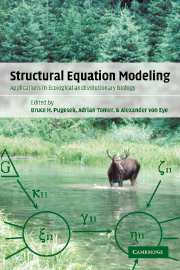Book contents
- Frontmatter
- Contents
- List of contributors
- Preface
- Section 1 Theory
- Section 2 Applications
- 6 Modeling intraindividual variability and change in bio-behavioral developmental processes
- 7 Examining the relationship between environmental variables and ordination axes using latent variables and structural equation modeling
- 8 From biological hypotheses to structural equation models: the imperfection of causal translation
- 9 Analyzing dynamic systems: a comparison of structural equation modeling and system dynamics modeling
- 10 Estimating analysis of variance models as structural equation models
- 11 Comparing groups using structural equations
- 12 Modeling means in latent variable models of natural selection
- 13 Modeling manifest variables in longitudinal designs – a two-stage approach
- Section 3 Computing
- Index
6 - Modeling intraindividual variability and change in bio-behavioral developmental processes
Published online by Cambridge University Press: 14 October 2009
- Frontmatter
- Contents
- List of contributors
- Preface
- Section 1 Theory
- Section 2 Applications
- 6 Modeling intraindividual variability and change in bio-behavioral developmental processes
- 7 Examining the relationship between environmental variables and ordination axes using latent variables and structural equation modeling
- 8 From biological hypotheses to structural equation models: the imperfection of causal translation
- 9 Analyzing dynamic systems: a comparison of structural equation modeling and system dynamics modeling
- 10 Estimating analysis of variance models as structural equation models
- 11 Comparing groups using structural equations
- 12 Modeling means in latent variable models of natural selection
- 13 Modeling manifest variables in longitudinal designs – a two-stage approach
- Section 3 Computing
- Index
Summary
Abstract
We present a basic rationale for studying intraindividual change processes in development and discuss some of the advantages and disadvantages of P-technique factor analyses for representing such change. An empirical example is presented to elucidate the application of the techniques and the interpretation of output. The data for our example come from observations of individual-level variables and social interactions of five Asian elephants (Elephas maximus). By referring to such a data base, we address many issues affecting observationally based data collection within intraindividual change designs. Although not commonly employed by developmentalists within the social and biological sciences, such designs can provide rich information for evaluating developmental theories.
- Type
- Chapter
- Information
- Structural Equation ModelingApplications in Ecological and Evolutionary Biology, pp. 143 - 170Publisher: Cambridge University PressPrint publication year: 2003
- 2
- Cited by

